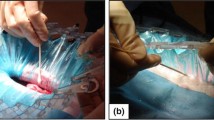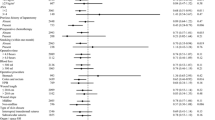Abstract
Purpose
We sought to compare the effectiveness of a novel antibiotic irrigation device to the standard O-ring wound retractor in preventing surgical site infections (SSIs) following colorectal resections.
Methods
This single-arm clinical trial included patients undergoing colorectal resections utilizing the novel device. A retrospective cohort of patients undergoing the same procedures with the O-ring retractor was selected as the control group. The primary outcome assessed was SSI. Secondary outcomes assessed were overall complications, hospital length of stay (LOS), and 30-day readmission. A univariable and multivariable logistic regression model was built to evaluate the association between SSI as the outcome variable and the use of the novel device as the main independent variable. The model was adjusted for any confounding variables.
Results
Eighty-six novel device cases and 170 O-ring retractor cases were enrolled. There were no significant differences between the two groups in terms of demographics and preoperative comorbidities. Cases with the novel device had fewer Pfannenstiel incisions (1.2% vs. 14.6%, p < 0.001). There were no other significant differences in intraoperative variables. SSI rates were significantly lower in the novel device group (1.2% vs. 9.1%, p = 0.014). There were no other significant differences in postoperative complications. Multivariable logistic regression with backward elimination showed that the use of the novel device was significantly more effective against SSI by 92.5% compared to the use of the O-ring retractor.
Conclusion
The novel device may contribute to lower SSI rates compared to the O-ring retractor following colorectal resection.
Similar content being viewed by others
Data availability
The data underlying this article cannot be shared publicly due to the privacy of individuals who participated in the study. The data will be shared on reasonable request to the corresponding author.
References
Elia-Guedea M, Cordoba-Diaz de Laspra E, Echazarreta-Gallego E et al (2017) Colorectal surgery and surgical site infection: is a change of attitude necessary? Int J Colorectal Dis 32:967–974. https://doi.org/10.1007/s00384-017-2801-0
Hennessey DB, Burke JP, Ni-Dhonochu T et al (2016) Risk factors for surgical site infection following colorectal resection: a multi-institutional study. Int J Colorectal Dis 31:267–271. https://doi.org/10.1007/s00384-015-2413-5
Papaconstantinou HT, Birnbaum EH, Ricciardi R, Margolin DA, Moesinger RC, Lichliter WE, Thomas JS, Bergamaschi R (2019) Impact of a novel surgical wound protection device on observed versus expected surgical site infection rates after colectomy using the national surgical quality improvement program risk calculator. Surg Infect (Larchmt) 20(1):35–38. https://doi.org/10.1089/sur.2018.112
Suh I, Long SA, Coe J, Koehler J, Fry D, Welton ML (2018) The efficacy of a novel surgical device in preventing intraoperative wound contamination in an in vivo porcine model. J Laparoendosc Adv Surg Tech A 28(4):445–451. https://doi.org/10.1089/lap.2017.0403. Epub 2017 Aug 28 PMID: 28846497
Falconer R, Ramsay G, Hudson J, Watson A, Highland Colorectal SSI Group (2021) Reducing surgical site infection rates in colorectal surgery - a quality improvement approach to implementing a comprehensive bundle. Colorectal Dis 23(11):2999–3007. https://doi.org/10.1111/codi.15875. Epub 2021 Sep 2. PMID: 34396654
Capolupo GT, Lauricella S, Mascianà G, Caricato C, Angeletti S, Ciccozzi M, Coppola R, Caricato M (2019) O-ring protector in prevention of SSIs in laparoscopic colorectal surgery. JSLS 23(4):e2019.00048. https://doi.org/10.4293/JSLS.2019.00048. PMID: 31892788; PMCID: PMC6924502
Horiuchi T, Tanishima H, Tamagawa K, Matsuura I, Nakai H, Shouno Y, Tsubakihara H, Inoue M, Tabuse K (2007) Randomized, controlled investigation of the anti-infective properties of the Alexis retractor/protector of incision sites. J Trauma 62(1):212–215. https://doi.org/10.1097/01.ta.0000196704.78785.ae
Kirchhoff P, Clavien PA, Hahnloser D (2010) Complications in colorectal surgery: risk factors and preventive strategies. Patient Saf Surg 4:5. https://doi.org/10.1186/1754-9493-4-5
Papaconstantinou HT, Ricciardi R, Margolin DA et al (2018) A novel wound retractor combining continuous irrigation and barrier protection reduces incisional contamination in colorectal surgery. World J Surg 42:3000–3007. https://doi.org/10.1007/s00268-018-4568-z
R Core Team (2021) R: A language and environment for statistical R Foundation for Statistical Computing, Vienna, Austria. https://www.R-project.org/
Chomsky-Higgins K, Kahn JG (2019) Interventions and innovation to prevent surgical site infection in colorectal surgery: a cost-effectiveness analysis. J Surg Res 235:373–382. https://doi.org/10.1016/j.jss.2018.09.048. Epub 2018 Nov 13 PMID: 30691819
Malek AJ, Stafford SV, Papaconstantinou HT, Thomas JS (2021) Initial outcomes of a novel irrigating wound protector for reducing the risk of surgical site infection in elective colectomies. J Surg Res 265:64–70. https://doi.org/10.1016/j.jss.2021.02.054. Epub 2021 Apr 20 PMID: 33887653
Funding
Yosef Nasseri received honorarium in the amount of $2400 from Prescient Surgical.
Author information
Authors and Affiliations
Contributions
Yosef Nasseri and Moshe Barnajian proposed the main research question. They, as well as Kimberly Oka, wrote the main manuscript text. Eli Kasheri, Ruoyan Zhu, and Kimberly Oka assisted with data collection for the study. Abbas Smiley and Kimberly Oka performed the statistical analyses and prepared Tables 1–4. All authors, especially Jason Cohen and Joshua Ellenhorn, reviewed the manuscript.
Corresponding author
Ethics declarations
Ethics approval
Approval was obtained from the Cedars-Sinai Institutional Review Board #Pro00039937.
Consent to participate
Informed consent was obtained from all individual participants included in the study.
Competing interests
Yosef Nasseri received honorarium in the amount of $2400 from Prescient Surgical.
Additional information
Publisher's Note
Springer Nature remains neutral with regard to jurisdictional claims in published maps and institutional affiliations.
Rights and permissions
Springer Nature or its licensor (e.g. a society or other partner) holds exclusive rights to this article under a publishing agreement with the author(s) or other rightsholder(s); author self-archiving of the accepted manuscript version of this article is solely governed by the terms of such publishing agreement and applicable law.
About this article
Cite this article
Nasseri, Y., Kasheri, E., Zhu, R. et al. Novel antibiotic irrigation device versus standard O-ring wound retractor in the prevention of surgical site infection following colorectal resection. Int J Colorectal Dis 38, 252 (2023). https://doi.org/10.1007/s00384-023-04542-2
Accepted:
Published:
DOI: https://doi.org/10.1007/s00384-023-04542-2




